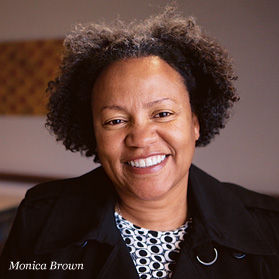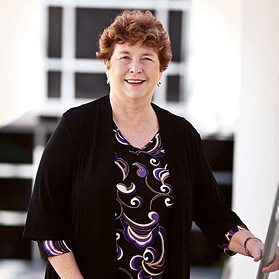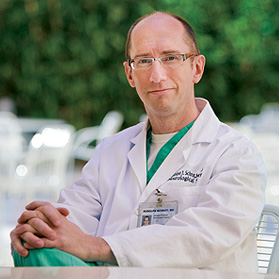Cancer by the numbers
 The state’s demographics allow researchers to analyze incidence, treatment, mortality, survival and trends of rare cancers and cancers among small or unique populations.
The state’s demographics allow researchers to analyze incidence, treatment, mortality, survival and trends of rare cancers and cancers among small or unique populations.
For more than a decade, a handful of UC Davis cancer researchers have collaborated with the registry on a variety of projects. But the potential of the partnership far exceeds the results produced so far.
Recognizing the gold mine at their doorstep, leaders of UC Davis Cancer Center now want to formalize their relationship with the registry by designating it a "shared resource." They hope to obtain funding to fortify the partnership under the center’s anticipated new five-year National Cancer Institute grant.
"Even without a formal shared resource, a tremendous number of meaningful papers have been written," says Ralph deVere White, cancer center director. "A partnership that allows for joint grant submissions will contribute to even more important research and will help boost research revenues for the state in these financially challenging times."
If approved, the shared resource will help fund the salaries of cancer epidemiologists trained to access and interpret the complex registry data. These epidemiologists will mentor junior faculty in developing projects, and collaborate with clinicians and translational scientists interested in mining the registry for research ideas.
Recognizing the gold mine at their doorstep, leaders of UC Davis Cancer Center now want to formalize their relationship with the registry by designating it a "shared resource."
Clinicians who have teamed up with registry staff on past projects are universally enthusiastic about the possibilities.
"Developing a shared resource in epidemiology would be a tremendous step toward building a fruitful and long-term collaboration between the cancer center and the registry," says Rudolph Schrot, assistant professor in the Department of Neurological Surgery and co-author of a study using registry data to examine brain tumors. "This partnership provides a great opportunity to expand our understanding of cancer incidence in California and investigate a wide range of population-based research questions."
Already, use of the registry has allowed researchers to document cancer trends, illuminate disparities in treatment and produce a string of findings that are helping guide patient care. Work anchored in registry data has targeted a wide range of cancers, from ovarian and kidney to lung, pancreas and nasopharyngeal cancers. Many of the projects have led to peer-reviewed publications and grant funding.
The registry first began gathering data in 1988, after the California Legislature required health officials to establish a statewide cancer reporting system. Each year, more than 162,000 new cases of cancer are added to the database, and both its size and tremendous diversity make it unique in the nation. State law permits the use of registry data by qualified researchers for cancer surveillance and research into the causes and cures of cancer.
 "My hope is that this will substantially increase the research collaborations between the registry and clinical researchers at the cancer center, leading to improvements in treatment for cancer patients and reductions in health care disparities."
"My hope is that this will substantially increase the research collaborations between the registry and clinical researchers at the cancer center, leading to improvements in treatment for cancer patients and reductions in health care disparities."
Californians represent 12 percent of the United States’ population and are rich in their racial/ethnic, economic and cultural diversity. The state’s demographics allow researchers to analyze incidence, treatment, mortality, survival and trends of rare cancers and cancers among small or unique populations. Thus the registry is a powerful resource for health-disparities research, a major focus at UC Davis.
The registry’s voluminous files include information on patient characteristics, cancer type, extent of disease at diagnosis, treatment and survival. The data are extremely reliable and representative, says Monica Brown, a registry epidemiologist who also has an adjunct faculty appointment at UC Davis.
"We receive reports on cancer cases from the tiniest doctor’s office right on up to the biggest hospital in the state, and we have excellent documentation of each case," Brown says. "The data are completely representative, and that’s very important for statistical analysis."
Registry staff members also routinely link their database with other administrative databases, including Medicare, MediCal and the state hospital discharge database. These connections allow the registry to enhance its files with information about treatment and the presence of other illnesses that can affect survival.
Schrot teamed up with Brown on a descriptive study examining brain tumors catalogued in the registry between 2001 and 2006. The study, which led to two articles published in April 2009 in the Journal of Neuro-Oncology, was the first large-scale population-based report that included malignant and benign tumors.
Schrot’s study also examined tumor incidence according to gender, race/ethnicity, socioeconomic status, and level of urbanization – rural or urban – based on census tracts.
"The broad diversity of the registry allowed us to do not just a comprehensive study, but also an in-depth analysis across various demographic groups," Schrot says. "So we were able to show, for example, that glioblastoma has the highest numbers in non-Hispanic white males, and incidence rates for benign tumors, such as meningioma, are very high in black females."
Beyond their intrinsic value, such descriptive studies form the foundation for future investigations and provoke new research questions, Schrot says, "such as why would some tumors be higher in some groups than in others? Is it genetics? Is it access to health care? Are there environmental factors?"
 "Developing a shared resource in epidemiology would be a tremendous step toward building a fruitful and long-term collaboration between the cancer center and the registry."
"Developing a shared resource in epidemiology would be a tremendous step toward building a fruitful and long-term collaboration between the cancer center and the registry."
Primo Lara Jr., a medical oncologist, professor of medicine and associate director for translational research at UC Davis Cancer Center, has partnered with the registry to investigate stage migration in non-small-cell lung cancer. The phenomenon describes a change in cancer staging because of technological advances that allow for more sensitive detection of tumor spread. He also has worked with the registry to study disparities in non-small-cell lung cancer therapy and outcomes, and trends in kidney cancer epidemiology in both the cytokine era and targeted therapy era. Much of this work has been published in major cancer journals.
Lara values the registry for its ability to "provide the investigator with the ‘30,000-foot view’ of the state’s cancer landscape, allowing one to identify and pursue research gaps in public health as it relates to oncology." Formalizing the partnership, he says, would give UC Davis researchers more tools to generate and test hypotheses and "pursue team-based science in cancer epidemiology."
Perhaps the most fruitful area of research involving registry data has focused on women’s cancers, an emphasis aided in 1999 when former Sen. Debra Ortiz (D-Sacramento) and other lawmakers set aside about $300,000 for the work. Most recently, in January’s online edition of the journal Gynecologic Oncology, UC Davis and registry researchers reported that more than a quarter of women with apparent early ovarian cancer do not receive the lymph node biopsies proven to improve patient survival.
Only 72 percent of patients with presumed early stage disease had lymph nodes from the pelvis and abdomen tested for signs of cancer spread, despite published professional guidelines for proper staging of the disease. Their findings were based on an analysis of medical records and registry data on more than 700 patients in California and New York. The results also showed that the five-year survival for women who, in the early stage of the disease, had the node biopsies was 84 percent, compared with 69 percent for those who did not have the tests.
The study’s lead author was Rosemary Cress, an epidemiologist and research program director at the registry, and an associate adjunct professor in the Department of Public Health Sciences at UC Davis. The senior author was Gary Leiserowitz, chief of gynecologic oncology at UC Davis Cancer Center.
It was not the first time the pair used registry data to produce important findings. Leiserowitz, benefitting from the linkage of registry files with a database of hospital deliveries, found in an earlier study that although ovarian masses are relatively common during pregnancy, they are not typically malignant, a conclusion that has allowed many women to avoid surgery while pregnant.
In another seminal finding, Lloyd Smith, professor in the Department of Obstetrics and Gynecology at UC Davis, teamed up with a registry research scientist to dispel the myth that ovarian cancer is a "silent disease," announcing itself only in late stages, when prognosis is poor. Instead, their study found that patients with ovarian cancer were more likely than two groups of other patients to report symptoms such as abdominal swelling and pain.
Cress and Brown, the duo of registry epidemiologists who have worked most closely on projects with UC Davis, are optimistic that the shared resource will pay off handsomely in terms of research and, ultimately, patient well-being.
"My hope is that this will substantially increase the research collaborations between the registry and clinical researchers at the cancer center, leading to improvements in treatment for cancer patients and reductions in health-care disparities," Cress says.
Adds Brown: "It’s really smart of UC Davis to continue building bridges between the campus and the registry. They recognized that they had a huge asset right in their backyard, and the staff at the registry are ready and willing partners."






